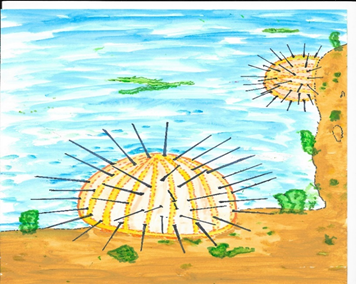| General Fiction posted August 17, 2020 | Chapters: |
...19 20 -21- 22... 
|
      |
U is for Urchin
A chapter in the book AmaZing Animals
Amazing Animals - U
by Sandra Stoner-Mitchell

I’m writing this ABC book for my 12 year-old grandson, Eric. I’ve found many interesting facts about the animals I’ve featured, and I hope children of all ages, 9 -109 will enjoy them, too.
U is for Urchin.
Sea urchins are small animals
that don’t have brains or eyes.
They can still sense when danger’s near,
regardless of their size.
All urchins will eat anything,
there’s not much they won’t try,
they’ll eat both plant and animal.
whatever they come by.
Fun facts on Urchins
Although sea urchins don’t have a skeleton, they do have a hard outer body which is called a ‘test’. It’s made of ten plates joined together,
wrapped around the sea urchins, then covered in spines.
Urchins are mostly spiny, ball-shaped animals that were given their name because up until the 1500s, hedgehogs were called urchins. Some of the spiny sea urchins look just like them.
Hedgehog Sea hedgehog


Images from Pixabay
*****
Even though urchins don’t have brains or eyes, they can ‘see’ with their tentacle-like tube feet. Scientists believe they have light sensors that not only detect light, but sense nearby predators, or anything that might harm them. These sensors are all over their bodies and along their spines.
In a new study, researchers from Lund University in Sweden have since tested their vision. They discovered that even though they have low sensory vision, for an animal with no eyes, it is good enough to meet their basic needs.
In order to move, the urchins will use their hundreds of sticky tube feet to crawl over rocks and sand. The water moving in and out of their bodies helps them control the movement of their feet. Their spines also help them walk by using a layer of muscle under the test, their hard outer body.

Image by Jerry Kirkhart via Wikimedia Commons
Their beak-like mouth, called ‘Aristotle’s Lantern,' has five sharp teeth that can drill through rock. This is on the underside of their bodies, which is handy for scraping their food off the rocks and other surfaces as they move along.

*****
In recent years, the soaring growth of the gluttonous purple sea urchin has devastated the huge forests of bull kelp (a type of seaweed) in the coastal waters of northern California. This kelp played a vital part in sheltering many other sea creatures.
It all began in 2013 when sea stars were suddenly wasting away from a mysterious illness. These sea stars played a vital part in their ecosystem. They preyed on the local purple urchins and kept their numbers in check.
Purple sea urchin Dying sea stars


With the loss of so many sea stars, mainly due to the rising temperature of the sea, the population of the purple urchins has soared. Now, without their main predator to stop them, these urchins, according to a recent study, have munched their way through ninety percent of the bull kelp along 217 miles of the California coast.

*****
Hatpin urchins are one of the largest known species from the deep waters off Japan. Hatpins from the Mediterranean and eastern Atlantic have toxic spines up to twelve inches long.
The slate pencil urchins are about five inches long and roughly a quarter of an inch thick, the same as a lead writing pencil.
There are many different types of flower sea anemones, and they do look lovely. Giacomo Merculiano painted a selection of them which I’ve shown below.
Although we don’t realise it because it’s not immediately obvious, when we touch sea anemones and corals, we can be seriously harming them. The human skin is coated with bacteria, and oils, which stay on it even in water. Flower urchins look lovely, but some can be highly poisonous. It’s best to leave them alone if you’re not sure.
Painted by Giacomo Merculiano (1859–1935) - The royal natural history, Public Domain,
https://commons.wikimedia.org/w/index.php?curid=11535111

Pencil urchin Hatpin urchin


*****
Extra fun facts
After researching several sites to discover how many urchin species there are in our oceans, the answers vary from 200 and 950. This would certainly make studying them difficult. What I did discover was they live in all our oceans in depths of 5,000 metres. (16,000 ft; 2,700 fathoms) They can also be found near coastal shorelines in little puddles.
Urchins have claw-like devices on the surface of their bodies, scattered among the spines. Their main purpose is protection against predators. Besides that, they are used for food collection and for the removal of foreign objects that get attached to their body.
Even though they are covered with sharp spines, they have many predators, like otters, fish, crabs and sun stars. However, the urchins are also being used by humans for a popular meal and the preparation of sushi. Some eat them raw and some fry them. Their eggs are another luxury food.


*****
On the other hand, a recent study concluded that the red sea urchin living in shallow coastal waters is among the longest living animals on Earth. They can live between one and two hundred years, but....
Sea pollution and overfishing are major threats to the survival of sea urchins. Because of their decreased numbers in the wild, they are on the threatened species list, and could very likely become endangered in the near future.
I’m writing this ABC book for my 12 year-old grandson, Eric. I’ve found many interesting facts about the animals I’ve featured, and I hope children of all ages, 9 -109 will enjoy them, too.
U is for Urchin.
Sea urchins are small animals
that don’t have brains or eyes.
They can still sense when danger’s near,
regardless of their size.
All urchins will eat anything,
there’s not much they won’t try,
they’ll eat both plant and animal.
whatever they come by.
Fun facts on Urchins
Although sea urchins don’t have a skeleton, they do have a hard outer body which is called a ‘test’. It’s made of ten plates joined together,
wrapped around the sea urchins, then covered in spines.
Urchins are mostly spiny, ball-shaped animals that were given their name because up until the 1500s, hedgehogs were called urchins. Some of the spiny sea urchins look just like them.
Hedgehog Sea hedgehog
Images from Pixabay
*****
Even though urchins don’t have brains or eyes, they can ‘see’ with their tentacle-like tube feet. Scientists believe they have light sensors that not only detect light, but sense nearby predators, or anything that might harm them. These sensors are all over their bodies and along their spines.
In a new study, researchers from Lund University in Sweden have since tested their vision. They discovered that even though they have low sensory vision, for an animal with no eyes, it is good enough to meet their basic needs.
In order to move, the urchins will use their hundreds of sticky tube feet to crawl over rocks and sand. The water moving in and out of their bodies helps them control the movement of their feet. Their spines also help them walk by using a layer of muscle under the test, their hard outer body.
Image by Jerry Kirkhart via Wikimedia Commons
Their beak-like mouth, called ‘Aristotle’s Lantern,' has five sharp teeth that can drill through rock. This is on the underside of their bodies, which is handy for scraping their food off the rocks and other surfaces as they move along.
*****
In recent years, the soaring growth of the gluttonous purple sea urchin has devastated the huge forests of bull kelp (a type of seaweed) in the coastal waters of northern California. This kelp played a vital part in sheltering many other sea creatures.
It all began in 2013 when sea stars were suddenly wasting away from a mysterious illness. These sea stars played a vital part in their ecosystem. They preyed on the local purple urchins and kept their numbers in check.
Purple sea urchin Dying sea stars
With the loss of so many sea stars, mainly due to the rising temperature of the sea, the population of the purple urchins has soared. Now, without their main predator to stop them, these urchins, according to a recent study, have munched their way through ninety percent of the bull kelp along 217 miles of the California coast.
*****
Hatpin urchins are one of the largest known species from the deep waters off Japan. Hatpins from the Mediterranean and eastern Atlantic have toxic spines up to twelve inches long.
The slate pencil urchins are about five inches long and roughly a quarter of an inch thick, the same as a lead writing pencil.
There are many different types of flower sea anemones, and they do look lovely. Giacomo Merculiano painted a selection of them which I’ve shown below.
Although we don’t realise it because it’s not immediately obvious, when we touch sea anemones and corals, we can be seriously harming them. The human skin is coated with bacteria, and oils, which stay on it even in water. Flower urchins look lovely, but some can be highly poisonous. It’s best to leave them alone if you’re not sure.
Painted by Giacomo Merculiano (1859–1935) - The royal natural history, Public Domain,
https://commons.wikimedia.org/w/index.php?curid=11535111
Pencil urchin Hatpin urchin
*****
Extra fun facts
After researching several sites to discover how many urchin species there are in our oceans, the answers vary from 200 and 950. This would certainly make studying them difficult. What I did discover was they live in all our oceans in depths of 5,000 metres. (16,000 ft; 2,700 fathoms) They can also be found near coastal shorelines in little puddles.
Urchins have claw-like devices on the surface of their bodies, scattered among the spines. Their main purpose is protection against predators. Besides that, they are used for food collection and for the removal of foreign objects that get attached to their body.
Even though they are covered with sharp spines, they have many predators, like otters, fish, crabs and sun stars. However, the urchins are also being used by humans for a popular meal and the preparation of sushi. Some eat them raw and some fry them. Their eggs are another luxury food.
*****
On the other hand, a recent study concluded that the red sea urchin living in shallow coastal waters is among the longest living animals on Earth. They can live between one and two hundred years, but....
Sea pollution and overfishing are major threats to the survival of sea urchins. Because of their decreased numbers in the wild, they are on the threatened species list, and could very likely become endangered in the near future.
 Recognized |
Any errors, I'd be most grateful if you let me know. Thank you! This is written in UK English.

© Copyright 2024. Sandra Stoner-Mitchell All rights reserved. Registered copyright with FanStory.

Sandra Stoner-Mitchell has granted FanStory.com, its affiliates and its syndicates non-exclusive rights to display this work.


